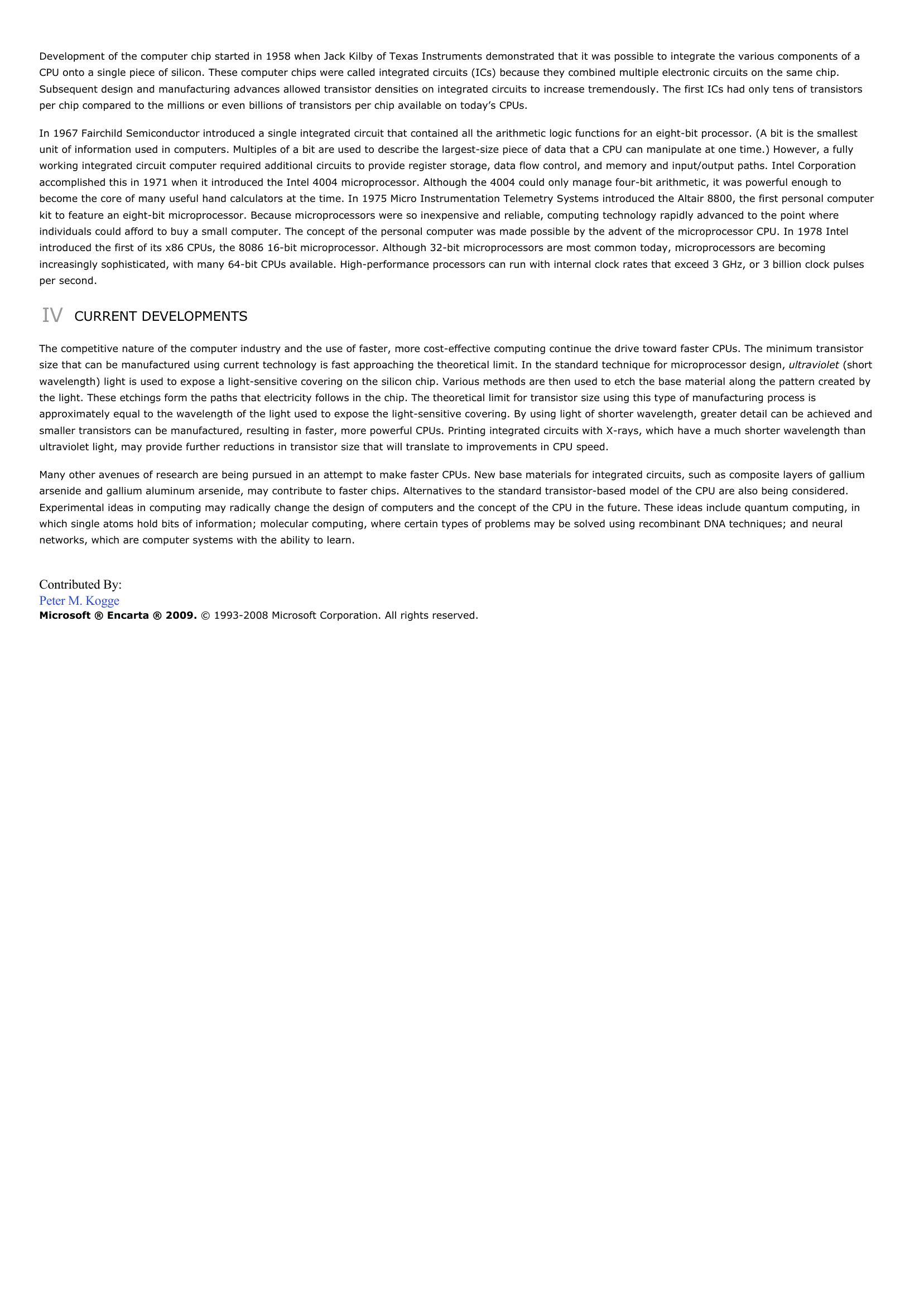Central Processing Unit.
Publié le 11/05/2013
Extrait du document
«
Development of the computer chip started in 1958 when Jack Kilby of Texas Instruments demonstrated that it was possible to integrate the various components of aCPU onto a single piece of silicon.
These computer chips were called integrated circuits (ICs) because they combined multiple electronic circuits on the same chip.Subsequent design and manufacturing advances allowed transistor densities on integrated circuits to increase tremendously.
The first ICs had only tens of transistorsper chip compared to the millions or even billions of transistors per chip available on today’s CPUs.
In 1967 Fairchild Semiconductor introduced a single integrated circuit that contained all the arithmetic logic functions for an eight-bit processor.
(A bit is the smallestunit of information used in computers.
Multiples of a bit are used to describe the largest-size piece of data that a CPU can manipulate at one time.) However, a fullyworking integrated circuit computer required additional circuits to provide register storage, data flow control, and memory and input/output paths.
Intel Corporationaccomplished this in 1971 when it introduced the Intel 4004 microprocessor.
Although the 4004 could only manage four-bit arithmetic, it was powerful enough tobecome the core of many useful hand calculators at the time.
In 1975 Micro Instrumentation Telemetry Systems introduced the Altair 8800, the first personal computerkit to feature an eight-bit microprocessor.
Because microprocessors were so inexpensive and reliable, computing technology rapidly advanced to the point whereindividuals could afford to buy a small computer.
The concept of the personal computer was made possible by the advent of the microprocessor CPU.
In 1978 Intelintroduced the first of its x86 CPUs, the 8086 16-bit microprocessor.
Although 32-bit microprocessors are most common today, microprocessors are becomingincreasingly sophisticated, with many 64-bit CPUs available.
High-performance processors can run with internal clock rates that exceed 3 GHz, or 3 billion clock pulsesper second.
IV CURRENT DEVELOPMENTS
The competitive nature of the computer industry and the use of faster, more cost-effective computing continue the drive toward faster CPUs.
The minimum transistorsize that can be manufactured using current technology is fast approaching the theoretical limit.
In the standard technique for microprocessor design, ultraviolet (short wavelength) light is used to expose a light-sensitive covering on the silicon chip.
Various methods are then used to etch the base material along the pattern created bythe light.
These etchings form the paths that electricity follows in the chip.
The theoretical limit for transistor size using this type of manufacturing process isapproximately equal to the wavelength of the light used to expose the light-sensitive covering.
By using light of shorter wavelength, greater detail can be achieved andsmaller transistors can be manufactured, resulting in faster, more powerful CPUs.
Printing integrated circuits with X-rays, which have a much shorter wavelength thanultraviolet light, may provide further reductions in transistor size that will translate to improvements in CPU speed.
Many other avenues of research are being pursued in an attempt to make faster CPUs.
New base materials for integrated circuits, such as composite layers of galliumarsenide and gallium aluminum arsenide, may contribute to faster chips.
Alternatives to the standard transistor-based model of the CPU are also being considered.Experimental ideas in computing may radically change the design of computers and the concept of the CPU in the future.
These ideas include quantum computing, inwhich single atoms hold bits of information; molecular computing, where certain types of problems may be solved using recombinant DNA techniques; and neuralnetworks, which are computer systems with the ability to learn.
Contributed By:Peter M.
KoggeMicrosoft ® Encarta ® 2009. © 1993-2008 Microsoft Corporation.
All rights reserved..
»
↓↓↓ APERÇU DU DOCUMENT ↓↓↓
Liens utiles
- POLYPHONTE. Personnage central de la tragédie de Voltaire Mérope
- L’enfant des bois En 1797, des paysans de la région de Laucane, dans le Massif Central, surprennent un enfant nu qui s’enfuit en courant à travers les bois de la Bassine.
- FEU CENTRAL de Benjamin Péret (résume et analyse complète)
- TCHITCHIKOV. Personnage central du roman de Gogol les Ames mortes
- NICOLAS. Personnage central de Monsieur Nicolas ou le Cœur humain dévoilé


